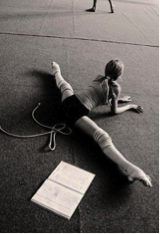Is Stretching a Useful Part of Sports Performance and Training?
 Recently there have been studies which have shown that prolonged static stretching, as a warm up, can reduce performance speed and power, and may not reduce the risk of injury. These studies measured 100m sprinters and found that warming up with active movement (e.g. light run throughs) resulted in greater speeds.
Recently there have been studies which have shown that prolonged static stretching, as a warm up, can reduce performance speed and power, and may not reduce the risk of injury. These studies measured 100m sprinters and found that warming up with active movement (e.g. light run throughs) resulted in greater speeds.
Other studies, which looked at performance sports, have found that static stretching immediately before the activity resulted in less strength, and explosive ability, during the sport.
What relevance does stretching have in sports training?
Generally, these findings conflict with common perception.
So how do we make sense of these findings?
What relevance does stretching have in sports training and performance?
Perhaps the best way to negotiate this territory is to come back to the principle of “Sports Specific Training”. For example, if the sport involves taking the body and limbs into extreme range-of-motion, then the body does need to be conditioned to do this. It also may be useful to keep in mind that stretching, when performed either directly after the activity or as an independent activity in itself, is still considered an essential part of sports training and performance.
Studies show that stretching improves flexibility and helps prevent injury
Studies have shown that stretching improves flexibility and helps prevent injury. We think the best way to determine what’s right for you, is by asking you: are you flexible enough to do the kind of sport and training that you want to do?
What is involved in sports specific training?
You may be wondering what a sports specific training warm-up would involve. We recommend commencing training with a warm up that involves some light cardio, and/or movement based exercise. It’s best to choose movements that are similar to those performed during the main part your training session or sport activity.
There are a range of exercises to choose from including:
- star jumps,
- knee lifts,
- jogging on the spot etc.
For sports activities which require flexibility the concept of dynamic flexibility is important.
To warm up for sports activities requiring flexibility, useful exercises are:
- walking deep lunges,
- swinging type leg raises,
- crossover reverse lunges.
If the sport involves ballistic (explosive or forceful) movements, then these types of movements need to be gradually introduced into the warm up.
When is the best time to stretch?
So when is the best time to incorporate stretching into my training program? It appears that the best time to work on improving your flexibility is towards the end of the session. At this time the body is warm, and the muscles have good blood flow. This is the time when a static stretch can be held passively for 30-60 sec or even longer.
It is advisable to do this type of stretching regularly at times other than when competing or training, as an independent activity in itself. This allows the joints and muscles to have better movement. Also, it may prevent injury in sports which involve taking the body parts outside normal movement patterns.
Interestingly, some studies found that this type of regular stretching, outside of competition and training, helped improve strength and power generation during the sports activity.
Stretching and flexibility are necessary for performance!
Perhaps the key take-away from this article is that stretching and flexibility are necessary for performance. However, keep in mind there are some sports, such as power lifting, where stretching may not be as important.
Here at MGS Physiotherapy we can advise you on how best to prepare for your chosen sport or training activity, and help you prevent unnecessary injury, whilst achieving maximum results.
Written by Matt Geister
MGS Physiotherapy
This article was written by Titled Musculoskeletal Physiotherapist, Matt Geister. Matt has been enjoying his work as a Physiotherapist in private practice for more than 20 years.
He is passionate about health and fitness. His background in Martial arts and acupuncture shows through with his approach to helping our clients.
Matt uses a variety of different manual therapy techniques to help people with pain, joint dysfunction, and postural conditions to improve their quality of life
.
